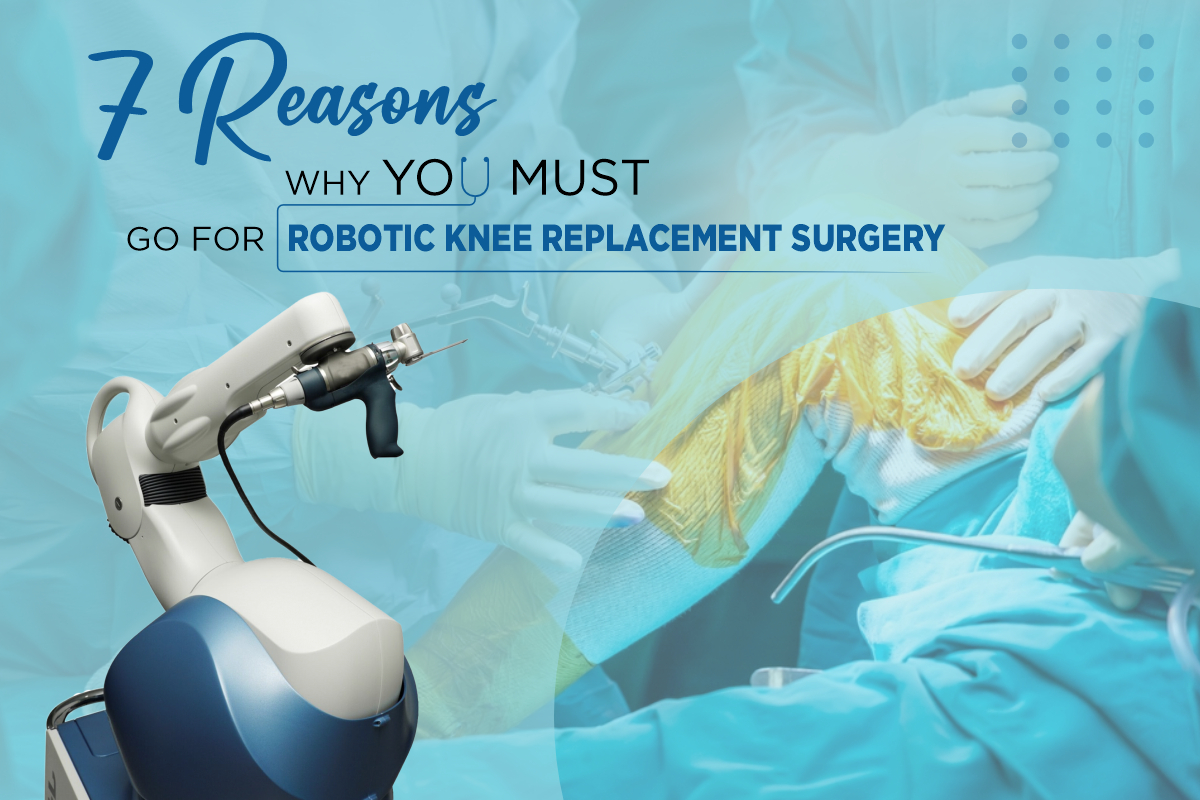7 Reasons Why You Must Go for Robotic Knee Replacement Surgery

Robotic knee replacement surgery stands at the forefront of orthopedic innovation, offering promising solutions for individuals grappling with knee joint degeneration and debilitating conditions. In India, where an aging population and an increasing prevalence of knee-related ailments pose significant healthcare challenges, the adoption of robotic-assisted procedures represents a pivotal advancement in orthopedic care. In this article we will deal with what advancements in robotic technology have contributed to the precision and efficacy of knee replacement surgery in India?
According to recent statistics from the Indian Orthopaedic Association, over 60 million Indians are estimated to suffer from knee osteoarthritis, a leading cause of disability and impaired mobility in the country.
Moreover, regulating upgrading data from the Ministry of Health and Family Welfare underscores the growing burden of knee-related conditions, with surgical interventions becoming increasingly necessary to alleviate pain and restore function.
Robotic knee replacement surgery brings a wave of innovation to the field of orthopedics. So What are the benefits of robotic knee replacement compared to traditional surgery?
Here are the 7 Things to Know About Robotic Knee Replacement.
1. Enhanced precision with Robot-assisted Surgery
From the many things to know about robotic knee replacement, the key is what is it? In a robotic knee replacement, advanced technology is utilized to assist surgeons in executing the procedure with enhanced precision. A robotic arm is employed to meticulously carry out the surgical plan devised by the surgeon beforehand. This approach ensures meticulous attention to detail, contributing to improved outcomes for patients.
While robotic-assisted surgery may slightly incur higher costs due to the investment in technology and specialised training, studies have shown that enhanced precision can lead to fewer complications and revision surgeries, potentially resulting in cost savings in the long term. Therefore, considering both the short-term and long-term cost implications is essential when evaluating the value of robotic-assisted knee replacement surgery.
2. Reduced Stiffness
One notable benefit of robotic knee replacement surgery is the potential for decreased post-operative stiffness. The precise guidance provided by the robotic system aids in achieving optimal alignment and positioning of the prosthetic components. Among the various things to know about robotic knee replacement, you must know that a meticulous approach may result in smoother articulation of the joint and reduced stiffness during the recovery period.
3. Improved Joint Alignment & Stability
Of the many happy features of the Things to Know robotic knee replacement, you must know that robotic assistance facilitates superior alignment and stability of the knee joint during replacement surgery. Robotic assistance employs advanced imaging technology to create a 3D model of the patient’s knee, allowing for meticulous pre-operative planning. During surgery, the robotic arm precisely executes the surgical plan, ensuring optimal alignment and stability of the joint. Real-time feedback from the robotic system allows for adjustments to be made with unparalleled accuracy, ensuring optimal joint function and long lasting life of the implant. This meticulous approach may lead to reduced risk of implant dislocation and improved long-term joint function.
4. Customised Implants tailored to the patient’s anatomy
Robotic technology enables the utilisation of customised implants tailored to the patient’s unique anatomy. Through advanced imaging and planning software, surgeons can develop a personalised surgical plan and select the most suitable implant size and design.
Robotic technology enables the creation of customized implants tailored to a patient’s unique knee anatomy. Advanced imaging generates detailed 3D models, allowing surgeons to select the optimal implant size, shape, and alignment. This personalized approach ensures a perfect fit, restores natural joint function, and addresses specific anatomical variations. Customized implants minimize the risk of loosening, enhance stability, and improve long-term outcomes, representing a significant advancement in knee replacement surgery.
5. Experience and Expertise of the surgeon is Very Important
While robotic assistance enhances surgical precision, the experience and expertise of the surgeon remain critical factors in achieving successful outcomes. Surgeons undergo specialized training to effectively utilize robotic systems and interpret the data provided. Therefore, selecting a surgeon with extensive experience in both traditional and robotic-assisted knee replacement techniques is essential for optimal results. They get the rights to operate here only after completing rigorous certification programs to ensure proficiency in utilizing robotic systems effectively.
Moreover, experience extends beyond mere technical proficiency. Seasoned surgeons possess a deep understanding of knee anatomy, biomechanics, and surgical principles honed through years of practice. This expertise enables them to interpret the real-time feedback provided by the robotic system accurately and make informed decisions during the procedure.
6. Minimally Invasive & less blood loss
Among the various things to know about robotic knee replacement, you must also know that this robotic assistance allows for smaller incisions and precise tissue sparing, resulting in reduced trauma to surrounding structures. This minimally invasive approach may lead to decreased post-operative pain, faster recovery times, and improved cosmetic outcomes for patients.
7. Faster Return to Normal Activities
Thanks to the precision and efficiency of robotic knee replacement surgery, patients may experience a quicker return to their usual activities compared to traditional surgery. Among the key Things to know about robotic knee replacement is that many patients report accelerated rehabilitation and improved functional outcomes. This expedited recovery allows patients to resume their daily activities sooner, with less discomfort and downtime.
The surge in demand for robotic knee replacements in Ahmedabad as well as in India, aligns with global trends indicating a paradigm shift toward technologically advanced surgical interventions. In 2023, Ahmedabad’s prominent hospitals reported a substantial 30% rise in the utilisation of robotic systems for knee replacements, underlining the increasing confidence in this transformative approach.
Why so? Because the unique aspect worth mentioning is the potential for intrao-perative feedback provided by robotic systems. These systems can assess soft tissue tension and joint balance in real time, allowing surgeons to make immediate adjustments as needed for optimal outcomes. This dynamic feedback loop enhances surgical precision and may contribute to improved long-term function and satisfaction for patients undergoing robotic knee replacement.
The statistics speak volumes, painting a vivid picture of the robotic knee replacement healthcare landscape in India and Ahmedabad that is embracing and driving the future of robotic-assisted orthopedic interventions.






